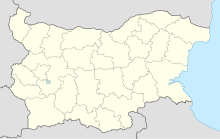Tourism in Bulgaria is a significant contributor to the country's economy. Situated at the crossroads of the East and West, Bulgaria has been home to many civilizations: Thracians, Greeks, Romans, Eastern Romans or Byzantines, Slavs, Bulgars, and Ottomans. The country is rich in tourist sights and historical artifacts, scattered through a relatively small and easily accessible territory. Bulgaria is internationally known for its seaside and winter resorts.
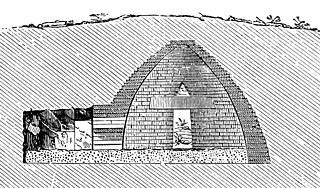
A beehive tomb, also known as a tholos tomb, is a burial structure characterized by its false dome created by corbelling, the superposition of successively smaller rings of mudbricks or, more often, stones. The resulting structure resembles a beehive, hence the traditional English name.

Kardzhali, sometimes spelt Kardžali or Kurdzhali, is a town in the Eastern Rhodopes in Bulgaria, centre of Kardzhali Municipality and Kardzhali Province. The noted Kardzhali Dam is located nearby.

The Rhodopes are a mountain range in Southeastern Europe, and the largest by area in Bulgaria, with over 83% of its area in the southern part of the country and the remainder in Greece. Golyam Perelik is its highest peak at 2,191 meters (7,188 ft). The mountain range gives its name to the terrestrial ecoregion Rodope montane mixed forests that belongs in the temperate broadleaf and mixed forests biome and the Palearctic realm. The region is particularly notable for its karst areas with their deep river gorges, large caves and specific sculptured forms, such as the Trigrad Gorge.
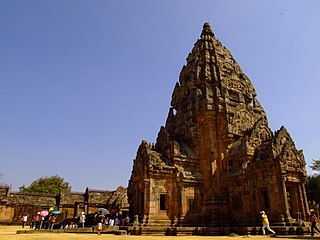
Phanom Rung Historical Park is an archaeological site in Thailand, covering the ruins of Prasat Phanom Rung, a Hindu Khmer Empire temple complex set on the rim of an extinct volcano at 402 metres (1,319 ft) elevation. It is located in Buriram Province in the Isan region of Thailand, and was built at a time when Khmer social-political influences were significant in Srisaket. It was built of sandstone and laterite between the 10th and 13th centuries. It was a Hindu shrine dedicated to Shiva, and symbolises Mount Kailash, his heavenly dwelling.

St. Michael's Cathedral Basilica is the cathedral church of the Roman Catholic Archdiocese of Toronto, Canada, and one of the oldest churches in Toronto. It is located at 65 Bond Street in Toronto's Garden District. St. Michael's was designed by William Thomas, designer of eight other churches in the city, and was primarily financed by Irish immigrants who resided in the area. The cathedral has a capacity of 1600. John Cochrane and Brothers undertook the work on the stone and stucco ornamentation of the interior.

The ancient Thracian city of Perperikon is located in the Eastern Rhodopes, 15 km northeast of the present-day town of Kardzhali, Bulgaria on a 470 m high rocky hill, which is thought to have been a sacred place. The village of Gorna krepost is located at the foot of the hill and the gold-bearing Perpereshka River flows nearby. Perperikon is the largest megalith ensemble site in the Balkans.

In ancient Roman religion, the Liberalia was the festival of Liber Pater and his consort Libera. The Romans celebrated Liberalia with sacrifices, processions, ribald and gauche songs, and masks which were hung on trees.

The Thracian religion comprised the mythology, ritual practices and beliefs of the Thracians, a collection of closely related ancient Indo-European peoples who inhabited eastern and southeastern Europe and northwestern Anatolia throughout antiquity and who included the Thracians proper, the Getae, the Dacians, and the Bithynians. The Thracians themselves did not leave an extensive written corpus of their mythology and rituals, but information about their beliefs is nevertheless available through epigraphic and iconographic sources, as well as through ancient Greek writings.

The Samothrace Temple Complex, known as the Sanctuary of the Great Gods, is one of the principal Pan-Hellenic religious sanctuaries, located on the island of Samothrace within the larger Thrace. Built immediately to the west of the ramparts of the city of Samothrace, it was nonetheless independent, as attested to by the dispatch of city ambassadors during festivals.

San Thome Church, officially known as St Thomas Cathedral Basilica and National Shrine of Saint Thomas, is a minor basilica of the Catholic Church in India, at the Santhome neighbourhood of Chennai, in Tamil Nadu. The present structure dates back to 1523 AD, when it was rebuilt by the Portuguese over what they believed was the tomb of Thomas the Apostle. In 1896, it was renovated in the Madras province according to neo-Gothic designs, as was favoured by British architects in the late 19th century.
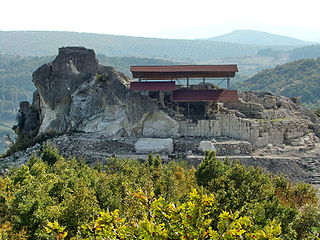
Tatul is a village in Momchilgrad municipality, Kardzhali Province located in the Eastern Rhodopes in southern Bulgaria. It is lies at 319 m above sea level at 41°33′13″N25°32′28″E, 15 km east of Momchilgrad, and as of September 2005 has a population of 189 people. Most of the houses were built of well-cut stone blocks.

Beglik Tash is a prehistoric rock sanctuary situated on the southern Black Sea coast of Bulgaria, a few kilometers north of the city of Primorsko. It was re-used by the Thracian tribes in the Iron Age.

Nikolay Ovcharov is a Bulgarian archaeologist and thracologist. Nikolay Ovcharov is known for his archaeological expeditions in Perperikon, a unique ancient Thracian city located in the eastern Rhodopes, as well as Tatul - the prehistoric surface tomb and sanctuary located near a village of the same name.
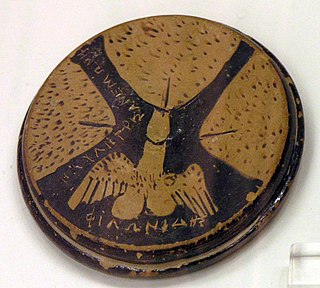
A phallus is a penis, an object that resembles a penis, or a mimetic image of an erect penis. In art history, a figure with an erect penis is described as ithyphallic.

The Church of St Nicholas is a partially preserved medieval Eastern Orthodox church in the town of Melnik in Blagoevgrad Province, southwestern Bulgaria. Dating to the late 12th century, it stands on top of an ancient Thracian sanctuary and a 5th-century basilica. In the Middle Ages, the church served as the cathedral of Melnik's bishop. The interior of the church features frescoes of rarely depicted scenes, as well as a 13th-century inscription. Its bell tower used to house one of the oldest extant church bells in Europe, discovered by archaeologists in the 2000s.

The Chalcolithic Temple of Ein Gedi is a Ghassulian public building dating from about 3500 BCE. It lies on a scarp above the oasis of Ein Gedi, on the western shore of the Dead Sea, within modern-day Israel. Archaeologist David Ussishkin has described the site as "a monumental edifice in terms of contemporary architecture".

Phallic architecture consciously or unconsciously creates a symbolic representation of the human penis. Buildings intentionally or unintentionally resembling the human penis are a source of amusement to locals and tourists in various places around the world. Deliberate phallic imagery is found in ancient cultures and in the links to ancient cultures found in traditional artifacts.

The Cathedral of Hajdúdorog, officially Greek Catholic Cathedral of the Presentation of Mary in Hajdúdorog is the cathedral of the Archeparchy of Hajdúdorog, Hungary. This status ranks the cathedral among the most important buildings of the Hungarian Greek Catholic Church. The origins of the current cathedral reaches back to 1312, when historical notes mention that a church existed in the medieval settlement of Dorogegyháza. However, the present building has 17th century foundations, and it went through several building extensions and renovations during its history. The latest restoration were completed in 2006.
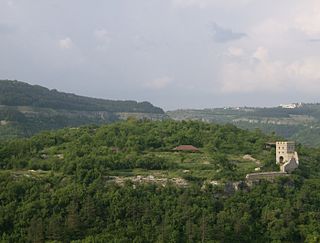
Trapezitsa is a medieval stronghold located on a hill with the same name in Veliko Tarnovo in northern Bulgaria.


